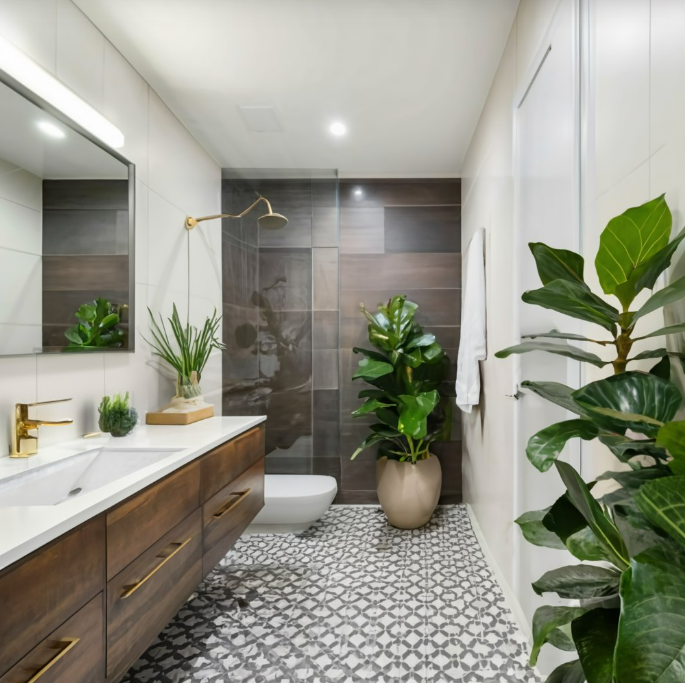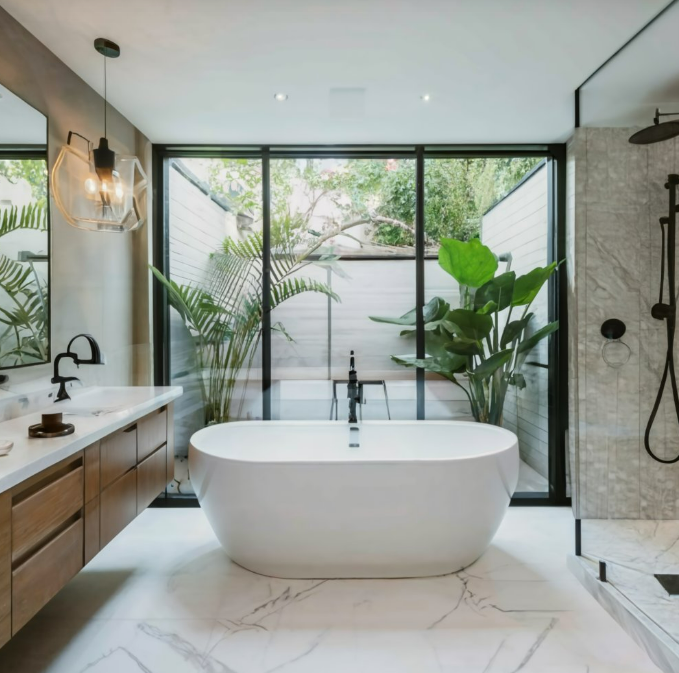Consider key factors such as layout, budget, and timeline when planning your bathroom renovation, ensuring a smooth and stress-free process from start to finish.
When planning a bathroom renovation, it’s essential to consider the environmental impact and explore sustainable design strategies. By prioritizing eco-friendly practices, homeowners in Singapore can create a stylish and functional bathroom that also reduces resource consumption and minimizes the carbon footprint. But have you ever wondered how a sustainable bathroom renovation can benefit both your home and the environment? Let’s dive in and explore the significance of sustainable and eco-friendly practices in bathroom design.
Key Takeaways
- Prioritizing water efficiency and incorporating water-saving fixtures can significantly reduce water consumption.
- Energy-efficient lighting and improved insulation and ventilation can enhance the overall energy efficiency of the bathroom.
- Selecting sustainable, recycled, and low-VOC materials can create a healthier indoor environment and minimize the environmental impact.
- Incorporating greywater systems can enable the reuse of water for non-potable purposes, promoting responsible water management.
- Sustainable bathroom design can help homeowners in Singapore reduce their environmental footprint while enhancing the functionality and aesthetics of their space.
Water Efficiency
Water efficiency is a crucial aspect of an eco-friendly bathroom renovation. By selecting water-efficient bathroom fixtures and incorporating greywater systems, homeowners can significantly reduce their water consumption and promote responsible water management.
Low-Flow Fixtures: Choosing Water-Saving Faucets, Showerheads, and Toilets
Upgrading to low-flow faucets, water-saving showerheads, and high-efficiency toilets can have a substantial impact on water conservation. These water-efficient bathroom fixtures use significantly less water compared to traditional models, making them an essential component of a sustainable bathroom design. Homeowners should research and select products that carry the WaterSense label, ensuring they meet the strict water-efficiency criteria set by the U.S. Environmental Protection Agency (EPA).
Greywater Systems: Incorporating Reclaimed Water for Toilet Flushing and Irrigation
Greywater systems offer a innovative approach to water reclamation, allowing homeowners to reuse water from sinks, showers, and washing machines for non-potable applications such as toilet flushing and landscape irrigation. By diverting this “greywater” from the main sewage system, these systems reduce the overall demand for fresh water and promote a more sustainable water management strategy within the home. Integrating a greywater system during a bathroom renovation can be a highly effective way to enhance water efficiency and minimize the environmental impact of the project.

Energy Conservation
Energy conservation is a crucial aspect of eco-friendly bathroom renovations. By upgrading to energy-efficient LED lighting and improving insulation and ventilation, homeowners can significantly reduce their carbon footprint and enhance the overall energy efficiency of the space.
LED Lighting: Installing Energy-Efficient LED Bulbs and Fixtures for Illumination
Traditional incandescent and halogen bulbs can consume significantly more energy than their LED lighting counterparts. By replacing these inefficient lighting solutions with energy-efficient LED bulbs and fixtures, homeowners can achieve substantial energy savings while maintaining excellent illumination in their bathrooms. LED lights not only use less electricity but also have a longer lifespan, reducing the need for frequent bulb replacements.

Insulation and Ventilation: Improving Energy Efficiency and Indoor Air Quality
Proper insulation and ventilation in the bathroom can have a significant impact on energy conservation and indoor air quality. Ensuring adequate insulation helps regulate the temperature, preventing unwanted heat loss or gain and reducing the demand on the sustainable HVAC systems. Effective ventilation, on the other hand, helps control moisture control and maintain indoor air quality, preventing the buildup of mold, mildew, and other indoor pollutants that can compromise the health and well-being of the occupants.
| Feature | Benefits |
|---|---|
| Energy-Efficient LED Lighting | Reduced energy consumption, longer lifespan, and improved illumination |
| Insulation and Ventilation | Enhanced energy efficiency, improved moisture control, and better indoor air quality |
Material Selection
When it comes to eco-friendly bathroom renovations, the selection of materials plays a crucial role in minimizing the overall environmental impact. Homeowners in Singapore can prioritize sustainable, recycled, and renewable materials to create a healthier indoor space and reduce the carbon footprint of their renovation project.
Sustainable Materials: Opting for Recycled, Renewable, or Locally Sourced Materials
By incorporating recycled materials, such as tiles made from recycled glass or countertops crafted from recycled paper, homeowners can reduce the demand for virgin resources and contribute to a more circular economy. Similarly, the use of renewable materials, like bamboo or cork flooring, can provide a long-lasting and eco-friendly solution for bathroom surfaces. Additionally, sourcing locally produced materials can help support the local economy and reduce the environmental impact associated with transportation.

Low VOC Products: Minimizing Off-Gassing and Indoor Air Pollution
In addition to sustainable material selection, homeowners should also prioritize the use of low-VOC (Volatile Organic Compound) products. These products, including paints, sealants, and adhesives, emit fewer harmful chemicals, helping to maintain a healthier indoor air quality and minimize off-gassing that can contribute to respiratory issues or other health concerns. By making informed choices about the materials used in their bathroom renovation, Singaporean homeowners can create a space that is not only visually appealing but also environmentally responsible and conducive to a healthy living environment.

